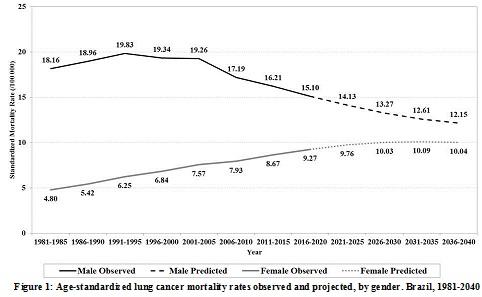Home
Issues
Aims and Scope
Open Access
Editorial Board
Indexing
Why publish with us
Contact us
Instructions to authors (PDF)
Manuscript Types
Manuscript Formatting
How to submit
Preprints
Special Publications & Reprints
Authorship & COI
Principles of Transparency Checklist
Data Policies
Publication Ethics and Publication Malpractice Statement
Impact of the reduction of smoking prevalence on the trend of lung cancer mortality in Brazil
1
Brazilian National Cancer Institute, Epidemiology Division, Brazil
Publication date: 2018-03-01
Tob. Induc. Dis. 2018;16(Suppl 1):A591
KEYWORDS
TOPICS
ABSTRACT
Background:
In Brazil the National Program for Tobacco Control is working for more than 30 years, and as consequence we can observe the reduction of smokers. The aim of this study is to evaluate the temporal trends in lung cancer mortality rates in Brazil observed from 1980 to 2015, and predicted estimates by 2040, by gender.
Methods:
A time series study was carried out, using data from the Mortality Information System and information on the resident population obtained from the Brazilian Institute for Geography and Statistics. Crude, specific and age-standardized mortality rates per 100,000 men (and women) were calculated for each year between 1980 and 2015. Mortality predictions were made for the period 2016-2040 utilizing Nordpred program based on the period of 1980-2015, using the APC (age-period-cohort) model.
Results:
While the decline in age-standardized lung cancer mortality rates has been most clearly observed for men since 2006, for women we will still experience a period of growth of these rates (2016-2025) followed by a period of stagnation (2026-2040) (Figure 1). Projections indicate that women aged 55-59 or younger will begin to experience a reduction in especific lung cancer mortality rates from 2021 onwards, but for women aged 75 or over these rates will continue to increase until 2040.

[Figure 1]
Conclusions:
The decline in lung cancer mortality among men since 2006, but not among women, reflects not only the different stages in the tobacco epidemic by gender, i.e., women started smoking after men, but also the successful implementation of a set of tobacco control actions in Brazil in the last 30 years. The last contributed to a strong reduction in the prevalence of smokers and, as a consequence, to a decline in current (and future) smoking-related morbidity and mortality.
In Brazil the National Program for Tobacco Control is working for more than 30 years, and as consequence we can observe the reduction of smokers. The aim of this study is to evaluate the temporal trends in lung cancer mortality rates in Brazil observed from 1980 to 2015, and predicted estimates by 2040, by gender.
Methods:
A time series study was carried out, using data from the Mortality Information System and information on the resident population obtained from the Brazilian Institute for Geography and Statistics. Crude, specific and age-standardized mortality rates per 100,000 men (and women) were calculated for each year between 1980 and 2015. Mortality predictions were made for the period 2016-2040 utilizing Nordpred program based on the period of 1980-2015, using the APC (age-period-cohort) model.
Results:
While the decline in age-standardized lung cancer mortality rates has been most clearly observed for men since 2006, for women we will still experience a period of growth of these rates (2016-2025) followed by a period of stagnation (2026-2040) (Figure 1). Projections indicate that women aged 55-59 or younger will begin to experience a reduction in especific lung cancer mortality rates from 2021 onwards, but for women aged 75 or over these rates will continue to increase until 2040.

[Figure 1]
Conclusions:
The decline in lung cancer mortality among men since 2006, but not among women, reflects not only the different stages in the tobacco epidemic by gender, i.e., women started smoking after men, but also the successful implementation of a set of tobacco control actions in Brazil in the last 30 years. The last contributed to a strong reduction in the prevalence of smokers and, as a consequence, to a decline in current (and future) smoking-related morbidity and mortality.
Share
RELATED ARTICLE
We process personal data collected when visiting the website. The function of obtaining information about users and their behavior is carried out by voluntarily entered information in forms and saving cookies in end devices. Data, including cookies, are used to provide services, improve the user experience and to analyze the traffic in accordance with the Privacy policy. Data are also collected and processed by Google Analytics tool (more).
You can change cookies settings in your browser. Restricted use of cookies in the browser configuration may affect some functionalities of the website.
You can change cookies settings in your browser. Restricted use of cookies in the browser configuration may affect some functionalities of the website.

